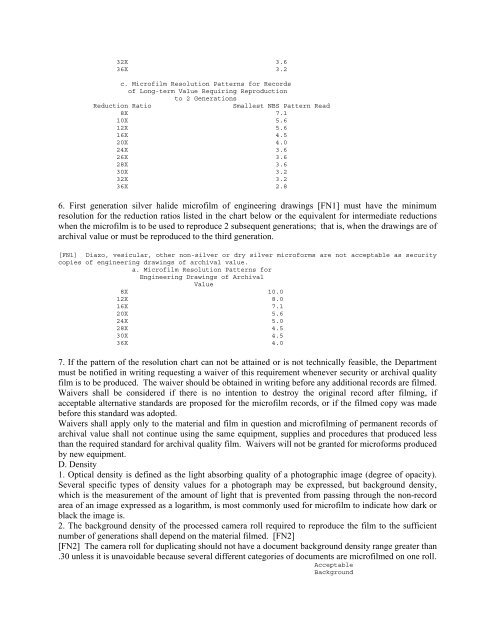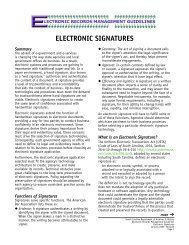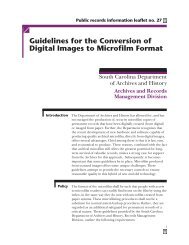Microfilm Standards - Records Management - State of South Carolina
Microfilm Standards - Records Management - State of South Carolina
Microfilm Standards - Records Management - State of South Carolina
You also want an ePaper? Increase the reach of your titles
YUMPU automatically turns print PDFs into web optimized ePapers that Google loves.
32X 3.636X 3.2c. <strong>Micr<strong>of</strong>ilm</strong> Resolution Patterns for <strong>Records</strong><strong>of</strong> Long-term Value Requiring Reproductionto 2 GenerationsReduction RatioSmallest NBS Pattern Read8X 7.110X 5.612X 5.616X 4.520X 4.024X 3.626X 3.628X 3.630X 3.232X 3.236X 2.86. First generation silver halide micr<strong>of</strong>ilm <strong>of</strong> engineering drawings [FN1] must have the minimumresolution for the reduction ratios listed in the chart below or the equivalent for intermediate reductionswhen the micr<strong>of</strong>ilm is to be used to reproduce 2 subsequent generations; that is, when the drawings are <strong>of</strong>archival value or must be reproduced to the third generation.[FN1] Diazo, vesicular, other non-silver or dry silver micr<strong>of</strong>orms are not acceptable as securitycopies <strong>of</strong> engineering drawings <strong>of</strong> archival value.a. <strong>Micr<strong>of</strong>ilm</strong> Resolution Patterns forEngineering Drawings <strong>of</strong> ArchivalValue8X 10.012X 8.016X 7.120X 5.624X 5.028X 4.530X 4.536X 4.07. If the pattern <strong>of</strong> the resolution chart can not be attained or is not technically feasible, the Departmentmust be notified in writing requesting a waiver <strong>of</strong> this requirement whenever security or archival qualityfilm is to be produced. The waiver should be obtained in writing before any additional records are filmed.Waivers shall be considered if there is no intention to destroy the original record after filming, ifacceptable alternative standards are proposed for the micr<strong>of</strong>ilm records, or if the filmed copy was madebefore this standard was adopted.Waivers shall apply only to the material and film in question and micr<strong>of</strong>ilming <strong>of</strong> permanent records <strong>of</strong>archival value shall not continue using the same equipment, supplies and procedures that produced lessthan the required standard for archival quality film. Waivers will not be granted for micr<strong>of</strong>orms producedby new equipment.D. Density1. Optical density is defined as the light absorbing quality <strong>of</strong> a photographic image (degree <strong>of</strong> opacity).Several specific types <strong>of</strong> density values for a photograph may be expressed, but background density,which is the measurement <strong>of</strong> the amount <strong>of</strong> light that is prevented from passing through the non-recordarea <strong>of</strong> an image expressed as a logarithm, is most commonly used for micr<strong>of</strong>ilm to indicate how dark orblack the image is.2. The background density <strong>of</strong> the processed camera roll required to reproduce the film to the sufficientnumber <strong>of</strong> generations shall depend on the material filmed. [FN2][FN2] The camera roll for duplicating should not have a document background density range greater than.30 unless it is unavoidable because several different categories <strong>of</strong> documents are micr<strong>of</strong>ilmed on one roll.AcceptableBackground





